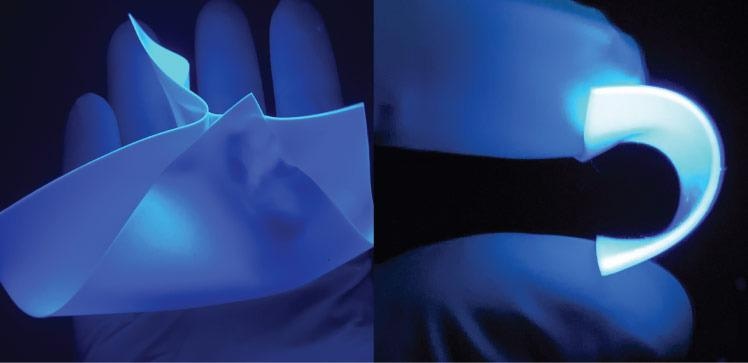There was a great deal of tinkering that took place to introduce lead-free metal halide powder into a scintillation screen. Nonetheless, a research team from King Abdullah University of Science and Technology (KAUST) has figured out the correct method.
 A new scintillation material developed by KAUST scientists can bring significant improvements to X-Ray imaging in medicine, industry and security. Image Credit: © 2022 KAUST.
A new scintillation material developed by KAUST scientists can bring significant improvements to X-Ray imaging in medicine, industry and security. Image Credit: © 2022 KAUST.
After the development of this technique, the researchers were able to generate a remarkably efficient, strong and flexible scintillation film to bring considerable enhancements in industrial, medical and security X-Ray imaging.
Scintillation materials tend to release visible light, also known as “scintillate,” in reaction to absorbing invisible X-ray high-energy photons. They are employed in the construction of digital images that help disclose the relative passage and obstruction of X-Rays as they experience any solid object, like a region of the body, an industrial component or an object that is being screened for security reasons.
Already, X-Ray scintillation is routinely used, but scientists are constantly exploring ways to make it more efficient, sensitive and readily adaptable.
Currently used materials suffer from several drawbacks, including complex and high-cost fabrication processes, radioluminescence afterglow and nontunable scintillation.
Yang Zhou, King Abdullah University of Science and Technology
Zhou is a postdoc in Omar Mohammed’s Lab.
The so-called lead halide perovskites materials have gained significant attention and shown considerable hope. Novel perovskites come under a category of materials that share the same crystal structure similar to that of the natural perovskite mineral calcium titanium oxide.
However, they include a range of different atoms that replace all or a few of those discovered in natural perovskite. Both lead and one or more elements of the halogen group, like chlorine, fluorine, bromine and iodine, have been integrated into lead halide perovskites.
In addition to the abilities of lead halide perovskites as X-Ray scintillators, their commercial applications are restricted by technical issues. This includes poor stability on exposure to light and air, reabsorption of few of the scintillated light, and the deadliness of lead.
All these issues have been overcome by the research group from KAUST by fabricating lead-free metal halides based on cesium, copper and iodide ions in the ratio Cs3Cu2I5, having crystals of that material integrated into thin and flexible films of the polymer polydimethylsiloxane.
The scientists say it was hard to get the copper halide powders distributed evenly in the film but eventually obtained this by dispersing the powder in a solvent prior to adding polydimethylsiloxane.
“Their flexible scintillation screens can detect X-rays at ultralow levels, approximately 113 times lower than a typical standard dose for X-ray medical imaging,” stated Omar Mohammed, leader of the research group.
Another vital advance is that the X-ray spatial resolution reported in this study is the highest achieved to date for powder-based screens.
Yang Zhou, King Abdullah University of Science and Technology
Mohammed added, “The physical flexibility of our films is also very important.”
He states that highly efficient flexible scintillation screens are urgently required for X-Rays so that awkward shapes can be better analyzed.
The team is already planning to commercialize their progress. They also hope to refine their fabrication methods and discover the ability of similar screens created from similar material compositions.
Journal Reference:
Zhou, Y., et al. (2022) Large-Area Perovskite-Related Copper Halide Film for High-Resolution Flexible X-ray Imaging Scintillation Screens. ACS Energy Letters. doi.org/10.1021/acsenergylett.2c00075